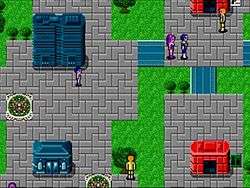Phantasy Star Collection
| Phantasy Star Collection | |
|---|---|
|
Japanese Box Art | |
| Developer(s) |
Sega (SS) Digital Eclipse (GBA) |
| Publisher(s) | Sega |
| Designer(s) |
Akinori Nishiyama and Rieko Kodama (writers / directors) Yuji Naka (producer / programmer) |
| Series | Phantasy Star |
| Platform(s) | Sega Saturn, Game Boy Advance, PlayStation 2 |
| Release date(s) |
Sega Saturn[1]
Game Boy Advance[2] PlayStation 2
PlayStation Network[3]
|
| Genre(s) | Role-playing video game |
| Mode(s) | Single-player |
Phantasy Star Collection is the name of two different compilations of Phantasy Star games. The first, released for the Sega Saturn in Japan in 1998, featured the first four games in the series, whereas the Game Boy Advance version, released four years later in North America, only featured the first three. The North American version was produced by Digital Eclipse.[4] The Saturn version was later ported to the PlayStation 2 in Japan with more games added.
Each compilation features ports of the original Phantasy Star games. They are virtually identical to their original versions, as opposed to enhanced remakes. Gameplay has not been altered in each of the collections.
Gameplay
Each game features overworld maps and separate dungeon areas, both with random encounters. Players control parties of characters, battling enemies and earning experience points to grow stronger. Certain characters can use different magic spells and techniques during and outside of battle. Phantasy Star's dungeons differ from the rest because they are in first-person, while the rest of the games use a top-down style.[5]
Plot
Although each game in the collections feature different characters and stories, they take place in the Algol planetary system, specifically on the planets Palma, Motavia, and Dezolis.[5] In the four games, there exists a Dark Force, a common antagonist that threatens the solar system. The games also make small references to each other, such as the idolation of Alis in Phantasy Star IV.
Development

Its first incarnation was released in 1998 on the Sega Saturn, as part of Sega's Sega Ages series of classics that included Space Harrier, Out Run, After Burner, and Fantasy Zone. Although the former three games listed emerged in the West as a single compilation, Phantasy Star Collection remains a Japan only title. It included what is considered the main entries in the series, with select enhancements such as the option of playing the games in katakana or hiragana (they originally were katakana only), and an optional speed increase for party members in Phantasy Star III. Due to the native resolution of the Mark III, the original Phantasy Star is played in a frame. Omake features were also included with the game, such as exclusive arranged music, art galleries, and Japanese commercials.
The Game Boy Advance version, produced by Digital Eclipse, emerged in 2002. Unlike the Sega Saturn release, Phantasy Star IV: The End of the Millennium was not included.[4] The video games themselves were also altered in order to function adequately on the Game Boy Advance's resolution. The GBA version has a reduced number of save slots available for Phantasy Star and Phantasy Star II. The GBA version does not include any extras.
The PlayStation 2 version, part of Sega's PS2 line of Sega Ages titles, is essentially identical to the Sega Saturn version. Unlike Phantasy Star Generation 1 and Phantasy Star Generation 2, none of the games have received any enhancements beyond the options included in the Sega Saturn version but therefore are available in their original Japanese version as well as their English localized counterparts.
Reception
| Reception | ||||||||||||||||||||||||||||||
|---|---|---|---|---|---|---|---|---|---|---|---|---|---|---|---|---|---|---|---|---|---|---|---|---|---|---|---|---|---|---|
| ||||||||||||||||||||||||||||||
Phantasy Star Collection's North American release was met with generally favorable reviews, earning an aggregate score of 76 out of 100 on MetaCritic.[7] Critics noted that although the game was outdated, it still held up with its innovations to the genre.[4][5] They praised the games' uniqueness upon their original release as well as the fact that all three games come on one cartridge. Tim Tracy of GameSpot noted that "Longtime fans of the series will definitely be pleased with the results, and it's worth mentioning that all three of these games originally retailed for about $70 each."[4]
Tracy criticized the omission of Phantasy Star IV, calling it possibly the best out of them, or "better than III".[4] Adam Tierney of IGN complained that Digital Eclipse did not do anything for the ports, mentioning the "tinny" music, "grammatical errors", and "huge crash bugs", but he gave the game a passable six out of ten.[5]
References
- ↑ "Release Information for Sega Saturn".
- ↑ "Release Information for Game Boy Advance".
- ↑ "Release Information for Playstation Network".
- 1 2 3 4 5 6 Tracy, Tim (2002). "Phantasy Star Collection review at GameSpot". GameSpot. Retrieved 2010-01-29.
- 1 2 3 4 5 Tierney, Adam (2002). "Phantasy Star Collection review at IGN". IGN. Retrieved 2010-01-29.
- 1 2 http://www.gamerankings.com/gba/560435-phantasy-star-collection/index.html
- 1 2 3 4 "Phantasy Star Collection at Metacritic". Metacritic. Retrieved 2010-01-29.
- ↑ Game Informer, February 2003, page 108
- ↑ GMR, February 2003, page 75
- ↑ https://web.archive.org/web/20030117040537/www.nintendojo.com/reviews/GB/view_item.php?1040871692
- ↑ Pocket Games, Spring 2003, page 36
